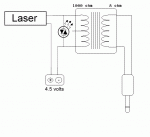lazer
0
- Joined
- Dec 21, 2008
- Messages
- 361
- Points
- 0
I built a transmitter that uses a small 5mw laser to transfer sounds and music to a receiver. I am having problems with static though. I get alot of background static. Does anyone know of a circuit which could counteract all the static. Maybe some kind of filter type circuit? I dont know what you would call it. Do you guys think an op amp would help?
I also have another minor problem, the transmitter input volume has to be really loud, as in maxed out. I found that is I give more power to the receiver it helps a little but not much. Is there a way I could amplify the input to the transmitter to make the receiver's output louder?
The reciever is just a small photocell hooked to a 9v battery with a mono plug.
This is the transmitter wiring diagram:
I also have another minor problem, the transmitter input volume has to be really loud, as in maxed out. I found that is I give more power to the receiver it helps a little but not much. Is there a way I could amplify the input to the transmitter to make the receiver's output louder?
The reciever is just a small photocell hooked to a 9v battery with a mono plug.
This is the transmitter wiring diagram:
Attachments
Last edited:






